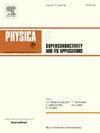Effects of extrinsic parameters on superconducting nanowire single-photon detector output – A study towards developing read-out circuit
IF 1
3区 物理与天体物理
Q4 PHYSICS, APPLIED
Physica C-superconductivity and Its Applications
Pub Date : 2025-02-28
DOI:10.1016/j.physc.2025.1354689
引用次数: 0
Abstract
A superconducting nanowire single-photon detector (SNSPD) is an optoelectrical device that works on the concept of hotspot formation and can detect a single photon. The associated readout circuit plays a vital role in determining the response of SNSPD. The available resources, complexity, and costs are major limiting factors in the actual readout circuit design. The preliminary information about the extrinsic effects that alter the SNSPD output from its desired value helps fabricate readout circuits. Here, the electrical equivalent circuit (EEC) for SNSPD has been simulated using LT spice software, and accordingly, a model has been developed to understand the readout circuit requirements. The EEC has been tested at room temperature by varying parameters like pulse width, bias voltage, capacitance and inductance. In addition, we have also designed and simulated a circuit for the multi-pixel photon counting scheme using a frequency multiplexing technique. Utilising this scheme, we observed that each EEC could be distinguished by its unique resonance frequency, reducing circuit complexity and power consumption. The results obtained indicate that their unique resonance frequency can identify triggered EEC.
外部参数对超导纳米线单光子探测器输出的影响——研制读出电路的研究
超导纳米线单光子探测器(SNSPD)是一种基于热点形成概念的光电器件,可以探测单个光子。相关的读出电路在决定SNSPD的响应中起着至关重要的作用。可用的资源、复杂性和成本是实际读出电路设计的主要限制因素。有关使SNSPD输出偏离其期望值的外在效应的初步信息有助于制造读出电路。在这里,使用LT spice软件对SNSPD的等效电路(EEC)进行了模拟,并相应地开发了一个模型来理解读出电路的要求。在室温下,通过改变脉冲宽度、偏置电压、电容和电感等参数对EEC进行了测试。此外,我们还设计并模拟了一个使用频率复用技术的多像素光子计数方案电路。利用这种方案,我们观察到每个EEC可以通过其独特的谐振频率来区分,从而降低了电路的复杂性和功耗。结果表明,它们独特的共振频率可以识别触发的脑电图。
本文章由计算机程序翻译,如有差异,请以英文原文为准。
求助全文
约1分钟内获得全文
求助全文
来源期刊
CiteScore
2.70
自引率
11.80%
发文量
102
审稿时长
66 days
期刊介绍:
Physica C (Superconductivity and its Applications) publishes peer-reviewed papers on novel developments in the field of superconductivity. Topics include discovery of new superconducting materials and elucidation of their mechanisms, physics of vortex matter, enhancement of critical properties of superconductors, identification of novel properties and processing methods that improve their performance and promote new routes to applications of superconductivity.
The main goal of the journal is to publish:
1. Papers that substantially increase the understanding of the fundamental aspects and mechanisms of superconductivity and vortex matter through theoretical and experimental methods.
2. Papers that report on novel physical properties and processing of materials that substantially enhance their critical performance.
3. Papers that promote new or improved routes to applications of superconductivity and/or superconducting materials, and proof-of-concept novel proto-type superconducting devices.
The editors of the journal will select papers that are well written and based on thorough research that provide truly novel insights.

 求助内容:
求助内容: 应助结果提醒方式:
应助结果提醒方式:


